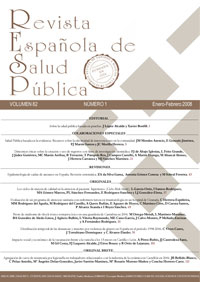Outbreak of Streptococcal Toxic Shock Syndrome in a Day Care Center in Cantabria, Spain, 2006
Abstract
Background: Beta hemolytic group A streptococcus only exceptionally produces aggressive disease with high lethality. Even more uncommon is the occurrence of an outbreak. In Spain, no outbreak in child care center has been previously described. Methods: Descriptive study of an outbreak of streptococcal toxic shock syndrome (3 cases, one lethal) in a child care center, which motivated the health care intervention with chemoprophylaxis, the closure of the child care center and the study of contacts. We analyzed the determinants of infection in the invasive and non-invasive cases, and the results of the pharyngeal culture of contacts. Results: We identified 3 invasive and 14 non-invasive cases between 40 children attending the child care center (attack rate 42.5%). We studied 19 possible determinants of the infection, finding only an association with being over the age of 24 months and the assistance to the handouts classroom (that of the oldest children). It was not associated with chickenpox. All children attending the child care center, its staff (4 women) and 258 contacts were microbiologically investigated. In 12 children the emm 4 strain was isolated, including 2 of 3 cases with invasive disease. In 13 of 258 contacts other strains of beta hemolytic group A streptococcus were isolated, but in none of them the strain responsible of the outbreak was found. Azytromicin chemoprophylaxis was implemented for all children and contacts, and in those with a positive isolation, the culture was repeated until negative. Conclusions: The invasive strain circulated only in the child care center. Azytromicin chemoprophylaxis eradicated effectively the infection.Downloads
Published
2008-03-14
Issue
Section
ORIGINALS

